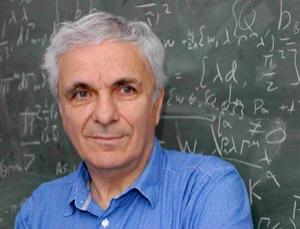The big news today is the announcement of the nominees for the 2014 Fundamental Physics Prize: (1) Michael Green and John Schwarz, for pioneering contributions to string theory, (2) Joseph Polchinski, for discovering the central role of D-branes in string theory, and (3) Andrew Strominger and Cumrun Vafa, for discovering (using D-branes) the microscopic origin of black hole entropy in string theory. As in past years, all the nominees are marvelously deserving. The winner of the $3 million prize will be announced in San Francisco on December 12; the others will receive the $300,000 Physics Frontiers Prize.
I wrote about my admiration for Joe Polchinski when he was nominated last year, and I have also greatly admired the work of Strominger and Vafa for many years. But the story of Green and Schwarz is especially compelling. String theory, which was originally proposed as a theory of the strong interaction, had been an active research area from 1968 through the early 70s. But when asymptotic freedom was discovered in 1973, and quantum chromodynamics became clearly established as the right theory of the strong interaction, interest in string theory collapsed. Even the 1974 proposal by Scherk and Schwarz that string theory is really a compelling candidate for a quantum theory of gravity failed to generate much excitement.
A faithful few continued to develop string theory through the late 70s and early 80’s, particularly Green and Schwarz, who began collaborating in 1979. Together they clarified the different variants of the theory, which they named Types I, IIA, and IIB, and which were later recognized as different solutions to a single underlying theory (sometimes called M-theory). In retrospect, Green and Schwarz were making remarkable progress, but were still largely ignored.
In 1983, Luis Alvarez-Gaume and Edward Witten analyzed the gravitational anomalies that afflict higher dimensional “chiral” theories (in which left-handed and right-handed particles behave differently), and discovered a beautiful cancellation of these anomalies in the Type IIB string theory. But anomalies, which render a theory inconsistent, seemed to be a nail in the coffin of Type I theory, at that time the best hope for uniting gravitation with the other fundamental (gauge) interactions.
Then, working together at the Aspen Center for Physics during the summer of 1984, Green and Schwarz discovered an even more miraculous cancellation of anomalies in Type I string theory, which worked for only one possible gauge group: SO(32). (Within days they and others found that anomalies cancel for E8 X E8 as well, which provided the impetus for the invention of the heterotic string theory.) The anomaly cancellation drove a surge of enthusiasm for string theory as a unified theory of fundamental physics. The transformation of string theory from a backwater to the hottest topic in physics occurred virtually overnight. It was an exciting time.
When John turned 60 in 2001, I contributed a poem to a book assembled in his honor, hoping to capture in the poem the transformation that Green and Schwarz fomented (and also to express irritation about the widespread misspelling of “Schwarz”). I have appended the poem below, along with the photo of myself I included at the time to express my appreciation for strings.
I’ll be delighted if Polchinski, or Strominger and Vafa win the prize — they deserve it. But it will be especially satisfying if Green and Schwarz win. They started it all, and refused to give up.
To John Schwarz
Thirty years ago or more
John saw what physics had in store.
He had a vision of a string
And focused on that one big thing.
But then in nineteen-seven-three
Most physicists had to agree
That hadrons blasted to debris
Were well described by QCD.
The string, it seemed, by then was dead.
But John said: “It’s space-time instead!
The string can be revived again.
Give masses twenty powers of ten!”
Then Dr. Green and Dr. Black,
Writing papers by the stack,
Made One, Two-A, and Two-B glisten.
Why is it none of us would listen?
We said, “Who cares if super tricks
Bring D to ten from twenty-six?
Your theory must have fatal flaws.
Anomalies will doom your cause.”
If you weren’t there you couldn’t know
The impact of that mightly blow:
“The Green-Schwarz theory could be true —
It works for S-O-thirty-two!”
Then strings of course became the rage
And young folks of a certain age
Could not resist their siren call:
One theory that explains it all.
Because he never would give in,
Pursued his dream with discipline,
John Schwarz has been a hero to me.
So please, don’t spell it with a “t”!







